For my first day of volunteer work, my host Ron decided the five of us should go see Portugal. So after a morning tea, a shot of blackberry infused whiskey, and a splash of water on the face we set off for the border. Our first stop was Miranda do Douro which is apt considering it resides on the cliffs right alongside the Douro River.
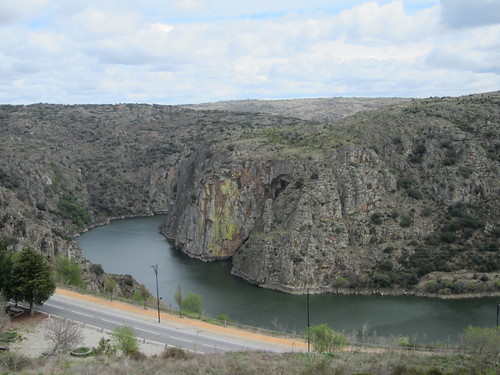 The most immediately noticeable thing as you approach the Portugese border is well... immediately noticeable. The drive from Ledesma was mile after mile of rolling hills plains dotted with trees and an endless series of medieval stone walls stacked to segregate one area of farmland from another. Then, out of the blue, the plains drop away amidst staggering cliffs which plunge down toward the Douro River below. After much weaving down the hillside, there is a dam near the bottom topped with a two lane road. Once across the road, you are in Portugal.
The most immediately noticeable thing as you approach the Portugese border is well... immediately noticeable. The drive from Ledesma was mile after mile of rolling hills plains dotted with trees and an endless series of medieval stone walls stacked to segregate one area of farmland from another. Then, out of the blue, the plains drop away amidst staggering cliffs which plunge down toward the Douro River below. After much weaving down the hillside, there is a dam near the bottom topped with a two lane road. Once across the road, you are in Portugal.
Back up the other side of the hill sits Miranda do Douro. In the days prior to the implementation of the Euro, Spaniards would come here to shop as the currency held considerably more weight and thus bargains abounded. Now, most of the shops hawk cheap collectibles... oh yes, and towels. Towels galore. Apparently any Portuguese border town is essentially Towelopolis.
After wandering around and not buying any towels, we walked up the street into old town, saw the church, and then proceeded to this great restaurant known by Ron for lunch. Lunch was one of the best meals of my life- a soup made of a local vegetable, fresh Portuguese bread (way better than Spanish bread) with butter, young goat cheese (incredible), and barbequed baby goat (kid). The baby goat was simply... otherworldly. It was marinated and then covered in a sauce of olive oil, bay leaves, vinegar, and some other spices but just those simple ingredients created an end product that was, just incredible.
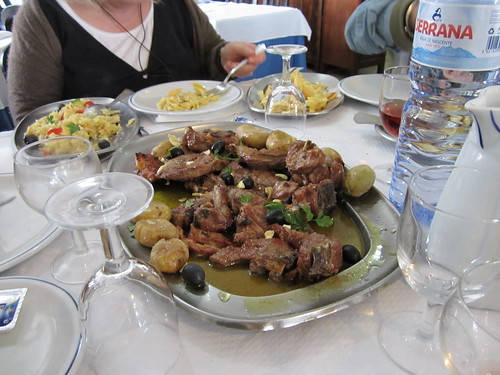 Our next stop was Freixo de Espada a Cinta, a very historic old town with an immensely high concentration of medieval buildings. In my mind, however, the most dramatic feature is the cemetery which sits on a hill behind the church. There are mausoleums and tombs and the whole thing looks out past the cliff on which it is situated. If I were to die on this trip, I'd want to be buried here.
Our next stop was Freixo de Espada a Cinta, a very historic old town with an immensely high concentration of medieval buildings. In my mind, however, the most dramatic feature is the cemetery which sits on a hill behind the church. There are mausoleums and tombs and the whole thing looks out past the cliff on which it is situated. If I were to die on this trip, I'd want to be buried here.
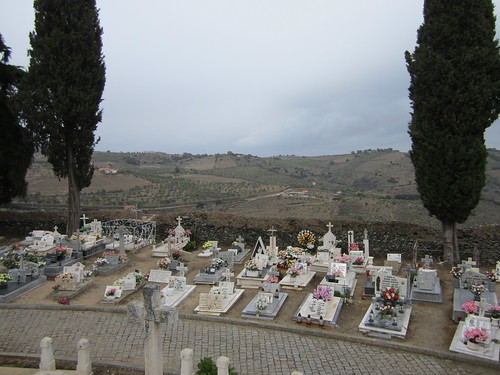 After a quick coffee we were on our way again. But not before checking out the column near the post office which was historically used for floggings, hangings, and death by garrote (a neck collar that was slowly tightened until you suffocated or your neck snapped). See below. Catholicism, it's to die for!
After a quick coffee we were on our way again. But not before checking out the column near the post office which was historically used for floggings, hangings, and death by garrote (a neck collar that was slowly tightened until you suffocated or your neck snapped). See below. Catholicism, it's to die for!
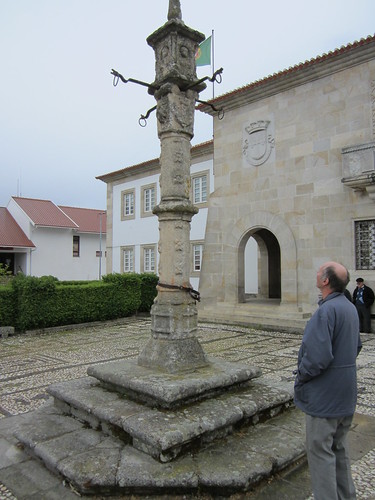 Next up we crossed back into Spain and then stopped to see this Bronze Age fort that has been immaculately preserved over the years. This thing is over 3000 years old and you can still see the stone carvings done by the children of the area along the outside of the wall. It was truly incredible. There are not many monuments of this scale and age that are as well preserved in the entire world. And the best part is that hardly anyone knows about it. Even most of the Spaniards nearby don't know it's there.
Next up we crossed back into Spain and then stopped to see this Bronze Age fort that has been immaculately preserved over the years. This thing is over 3000 years old and you can still see the stone carvings done by the children of the area along the outside of the wall. It was truly incredible. There are not many monuments of this scale and age that are as well preserved in the entire world. And the best part is that hardly anyone knows about it. Even most of the Spaniards nearby don't know it's there.
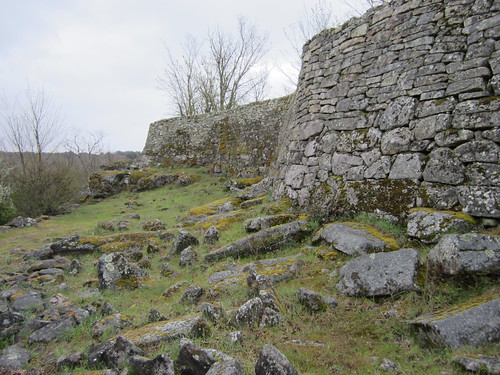 After taking in this incredible piece of history it was time to head home to enjoy the groceries and alcohol we picked up at the Portuguese supermarket, including some vinho verde (green wine- but meaning new or young wine), vinho verde tinto (red version), tawny port (aged port wine) and a really great cherry concoction called Ginginha which tasted like a mix between cherry brandy and amaretto. We drank and talked British law into the wee hours of the morning. So far I'm loving this bohemian lifestyle.
After taking in this incredible piece of history it was time to head home to enjoy the groceries and alcohol we picked up at the Portuguese supermarket, including some vinho verde (green wine- but meaning new or young wine), vinho verde tinto (red version), tawny port (aged port wine) and a really great cherry concoction called Ginginha which tasted like a mix between cherry brandy and amaretto. We drank and talked British law into the wee hours of the morning. So far I'm loving this bohemian lifestyle.
 The most immediately noticeable thing as you approach the Portugese border is well... immediately noticeable. The drive from Ledesma was mile after mile of rolling hills plains dotted with trees and an endless series of medieval stone walls stacked to segregate one area of farmland from another. Then, out of the blue, the plains drop away amidst staggering cliffs which plunge down toward the Douro River below. After much weaving down the hillside, there is a dam near the bottom topped with a two lane road. Once across the road, you are in Portugal.
The most immediately noticeable thing as you approach the Portugese border is well... immediately noticeable. The drive from Ledesma was mile after mile of rolling hills plains dotted with trees and an endless series of medieval stone walls stacked to segregate one area of farmland from another. Then, out of the blue, the plains drop away amidst staggering cliffs which plunge down toward the Douro River below. After much weaving down the hillside, there is a dam near the bottom topped with a two lane road. Once across the road, you are in Portugal.Back up the other side of the hill sits Miranda do Douro. In the days prior to the implementation of the Euro, Spaniards would come here to shop as the currency held considerably more weight and thus bargains abounded. Now, most of the shops hawk cheap collectibles... oh yes, and towels. Towels galore. Apparently any Portuguese border town is essentially Towelopolis.
After wandering around and not buying any towels, we walked up the street into old town, saw the church, and then proceeded to this great restaurant known by Ron for lunch. Lunch was one of the best meals of my life- a soup made of a local vegetable, fresh Portuguese bread (way better than Spanish bread) with butter, young goat cheese (incredible), and barbequed baby goat (kid). The baby goat was simply... otherworldly. It was marinated and then covered in a sauce of olive oil, bay leaves, vinegar, and some other spices but just those simple ingredients created an end product that was, just incredible.
 Our next stop was Freixo de Espada a Cinta, a very historic old town with an immensely high concentration of medieval buildings. In my mind, however, the most dramatic feature is the cemetery which sits on a hill behind the church. There are mausoleums and tombs and the whole thing looks out past the cliff on which it is situated. If I were to die on this trip, I'd want to be buried here.
Our next stop was Freixo de Espada a Cinta, a very historic old town with an immensely high concentration of medieval buildings. In my mind, however, the most dramatic feature is the cemetery which sits on a hill behind the church. There are mausoleums and tombs and the whole thing looks out past the cliff on which it is situated. If I were to die on this trip, I'd want to be buried here. After a quick coffee we were on our way again. But not before checking out the column near the post office which was historically used for floggings, hangings, and death by garrote (a neck collar that was slowly tightened until you suffocated or your neck snapped). See below. Catholicism, it's to die for!
After a quick coffee we were on our way again. But not before checking out the column near the post office which was historically used for floggings, hangings, and death by garrote (a neck collar that was slowly tightened until you suffocated or your neck snapped). See below. Catholicism, it's to die for! Next up we crossed back into Spain and then stopped to see this Bronze Age fort that has been immaculately preserved over the years. This thing is over 3000 years old and you can still see the stone carvings done by the children of the area along the outside of the wall. It was truly incredible. There are not many monuments of this scale and age that are as well preserved in the entire world. And the best part is that hardly anyone knows about it. Even most of the Spaniards nearby don't know it's there.
Next up we crossed back into Spain and then stopped to see this Bronze Age fort that has been immaculately preserved over the years. This thing is over 3000 years old and you can still see the stone carvings done by the children of the area along the outside of the wall. It was truly incredible. There are not many monuments of this scale and age that are as well preserved in the entire world. And the best part is that hardly anyone knows about it. Even most of the Spaniards nearby don't know it's there. After taking in this incredible piece of history it was time to head home to enjoy the groceries and alcohol we picked up at the Portuguese supermarket, including some vinho verde (green wine- but meaning new or young wine), vinho verde tinto (red version), tawny port (aged port wine) and a really great cherry concoction called Ginginha which tasted like a mix between cherry brandy and amaretto. We drank and talked British law into the wee hours of the morning. So far I'm loving this bohemian lifestyle.
After taking in this incredible piece of history it was time to head home to enjoy the groceries and alcohol we picked up at the Portuguese supermarket, including some vinho verde (green wine- but meaning new or young wine), vinho verde tinto (red version), tawny port (aged port wine) and a really great cherry concoction called Ginginha which tasted like a mix between cherry brandy and amaretto. We drank and talked British law into the wee hours of the morning. So far I'm loving this bohemian lifestyle.
No comments:
Post a Comment